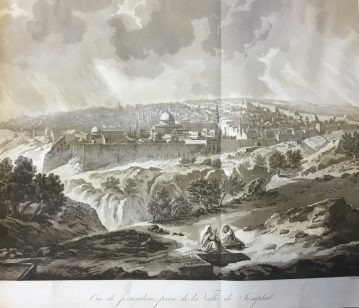Voyage dans le Levant en 1817 et 1818. TWO VOLUMES IN ONE: TEXT + ATLAS.
Forbin, Louis-Nicolas Philippe Auguste, Comte de 1779-1841.
Synopsis
First edition, Brunet states that 325 copies were printed. Two editions, the one marked “Seconde”, were also issued in 1819 with the text in 8vo and the folio plates to be purchased separately. Forbin’s was one of the first important French books to use lithography on a grand scale, and the standard of production is equal to that of Napoleon’s “Description de l’Égypte” or “Denon’s Voyage”. The plates are after drawings by Forbin, Isabey, Prevost, Fragonard and Carle Vernet. The aquatint plates are all after drawings by Forbin himself. Most of the plates illustrate scenes in Egypt and Syria, including one of Drovetti, French consul in Egypt, measuring a colossal head. The two unnumbered plates illustrate the catacombs of Milos and a diagram of the Holy Sepulchre.
In 1816 Forbin replaced Dominique Denon as Director of Museums of France, and in August 1817 he undertook a semi-official year-long voyage to the Levant, having been authorised to purchase antiquities for the Louvre. He travelled to Milos, where his son-in-law Marcellus had negotiated the purchase of the recently discovered Venus de Milo and from there he continued to Athens, Contantinople, Asia Minor, Syria and Palestine. From Jaffa he travelled overland to Alexandria and visited Egypt. His party included the artist Prevost and the engineer Linant de Bellfonds.
Bibliographic references: Atabey, 447; Blackmer, 614; Brunet II, 1337; Colas, 1089; Graesse II, 614; Röhricht, 1660; Tobler, 144-145; Hilmy I, 163 cites a copy with coloured plates.








